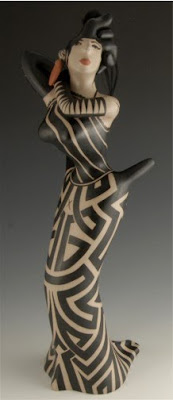Ah, Rodarte. The fashion line has committed a fashion faux pas, and Nadra Kareem over at
Race in America calls them on it. On many occasions, designers - like artists - are keenly aware of social issues. Other times, unfortunately, they seem to be in la-la land. Check it out:
 M.A.C.'s New Makeup Line Makes Light of Women Living in Deadly Juarez
M.A.C.'s New Makeup Line Makes Light of Women Living in Deadly Juarezby Nadra Kareem
M.A.C. Cosmetics and a designer duo known as Rodarte have apologized for collaborating on a new makeup line inspired by female factory workers in the deadly border town of Juarez, Mexico. And rightfully so.
The line features blush, eye shadow, nail polish and gloss in shades such as “Ghost Town,” “Sleepless,” “Factory” and “Quinceanera.” But this ode to maquila chic has outraged socially-conscious stylistas. That’s because since 1993, the bodies of about 800 women and girls, many of them young, indigenous factory workers, have surfaced in the Chihuahuan desert. Few arrests have been made in these killings, thanks to how those responsible are reportedly able to silence Juarez's corruption-plagued authorities.
Given the murders, what made Rodarte decide that it would be in good taste to launch a cosmetics line — not to mention a fashion collection — about the workers? Evidently, Kate and Laura Mulleavy, the sisters behind Rodarte, took a road trip last year to Marfa, Texas from El Paso, Texas, which borders Juarez.
“The ethereal nature of this landscape influenced the creative development and desert palette of the collection,” the sisters explained. “We are truly saddened about injustice in Juarez.”
I don’t doubt that the Mulleavy Sisters feel sorry for the factory workers in Juarez, but that didn’t prevent the duo from exoticizing — and marginalizing — the women in their cosmetics and fashion lines. In the runway show for Rodarte’s newest collection, models in pale foundation and heavy eye makeup donned layered pieces featuring goat hair, chiffon, shearling and lace. Think Olsen twins meet Mexican peasant.
If only Juarez was made up of peasant women. In fact, it is a city of 1.5 million people. The women there don’t herd sheep or look like extras from the set of a trite Mexican period piece. They wear jeans and T-shirts and heels and sneakers like women do in any big city.
Having lived in El Paso for two years, I’ve made more trips to Juarez than I remember, so I had ample opportunity to take in the local fashions. Viewing the Rodarte collection, however, I seriously question if the Mulleavy Sisters ever stepped foot there.
I understand that an undercurrent of fantasy always runs through fashion, but the Rodarte collection has practically no basis in reality, as far as the Juarez maquiladora workers are concerned. Seriously, why would factory workers cloak themselves in shawls and layered patchwork pieces that could easily get caught on machinery? I raise this point to suggest that the Mulleavy Sisters weren’t inspired by actual Mexican factory workers, but by their stereotypes of them. In short, in attempting to pay tribute to these women, they othered them, kind of like sports teams who claim to honor the Native American warriors they turn into mascots.
So were the Mulleavy Sisters wrong to launch a fashion collection “inspired” by the maquiladora workers? If fashion is art and art can effect social change, not necessarily. But the sisters erred by duping themselves and their audience into thinking they were representing reality. Those who viewed the show described it as playful and beautiful — a vision far removed from its so-called inspiration.
What if the show hadn’t stirred up such warm feelings but made viewers uncomfortable and appalled, as anyone who learns of the Juarez murders should be? What if before the show, the sisters hadn’t simply described taking a road trip to a place with a dreamy landscape, but prepared some words about the ongoing rape, mutilation and murder of Juarez's female factory workers? Perhaps the audience would’ve left motivated to learn more about the issue and take action.
In light of the controversy about the cosmetics line, M.A.C. recently announced that it will give a portion of the proceeds from the M.A.C. Rodarte collection to support those in Juarez. That’s a praiseworthy step. But it took serious public outcry to motivate the company to take it. If M.A.C. and Rodarte genuinely care about what’s happening along the border, they should have planned to raise funds and awareness for Juarez from the outset.
For more about this topic, read Oh Industry's article, Maquiladoras are In for Fall, or Thread Bared's article where you will find not only a video of Rodarte's fashion show, but also a video clip of the documentary on Maquiladoras.[Images of Rodarte's Fall 2010 line from
Coutorture.com]










































.jpg)









